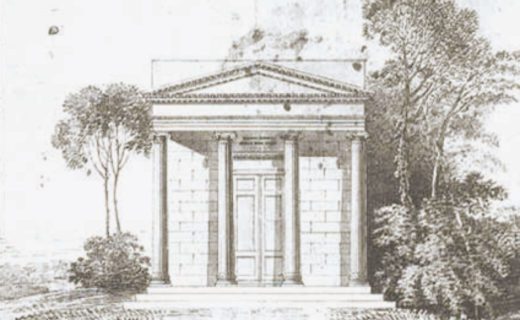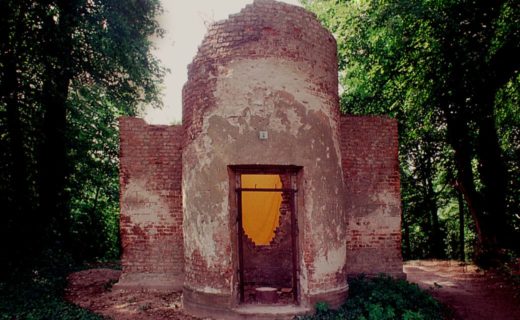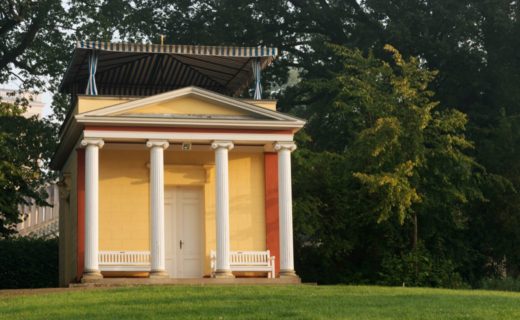Schinkel’s Treasure Trove
Anyone who chooses to scale the Pfingstberg in Potsdam will be rewarded with more than just the striking architecture of the Belvedere Palace. A small, but no less beautiful architectural treasure – the Temple of Pomona – awaits the explorer on the southern slope. It was the first constructed work of the architect Karl Friedrich Schinkel and it is quite exceptional. The building was commissioned in 1801 by the Prussian Privy Councilor and district administrator Carl Ludwig von Oesfeld, who owned a large vineyard that included the “Temple de Pomona” – a temple in honor of Pomona, the Roman goddess and benefactress of fruit. As a gift to his wife, von Oesfeld had the original temple torn down and rebuilt by Schinkel in a new design at a site on higher ground.
A Small Neoclassical Masterpiece in the Palace Garden
For his architectural journeyman’s piece, Schinkel chose to design a tea pavilion in the form of a Greek
temple. The building was based on the north façade of the Erechtheion on the Acropolis in Athens. Its
blue-and- white striped tent roof, used to adorn the roof terrace for social occasions in summer, was
presumably completed years later. It corresponds to the taste of that time and also to the interior
design at the other palaces, such as Charlottenhof Palace.
The King Dies, the Temple of Pomona is Allowed to Remain
When construction on the Belvedere began in 1847, Schinkel’s building was actually slated to be torn down, because it stood in the way of Frederick William IV’s large-scale plans for the palace, which would have included hanging gardens, open stairs and a water cascade. However, the king died before the building could be completed and the Belvedere remained an imposing, but “unfinished” structure. His successor William I had the palace completed on a reduced scale. The well-known landscape designer Peter Joseph Lenné, commissioned to design the gardens, integrated the Temple of Pomona into his landscaping and created harmonious conditions for it: A semicircular arcade cleverly conceals the asymmetrical position of Schinkel’s pavilion as it relates to the Belvedere while leading to it at the same time.
The Decline and Reconstruction of the Temple after 1945
Until the outbreak of World War II, the Temple of Pomona’s proximity to the Belvedere most certainly included it as a sight enjoyed by visitors to Pfingstberg. Prior to the Summer Olympics in Berlin, repair and restoration work was conducted on the structure from 1935–36, allowing the temple to bask in its full beauty one last time before the war. The building managed to survive the fighting without significant damage, even though it was used as a recreation area by anti-aircraft guards. However, after 1945 the structure fell into severe decline and ruin; right down to its foundation walls. Due to its nearness to the Soviet Military Camp No. 7 (Militärstädtchen Nr. 7), the Soviet garrison and the inner- German border after the division of Germany, for many years this architectural jewel, like the Belvedere, had been located on terrain that was very difficult to access.
Rediscovery and Reconstruction of the Historical Building
The engagement of young Potsdamers for the Belvedere Palace at the end of the 1980s once again brought the Temple of Pomona to public attention. The association, Förderverein Pfingstberg in Potsdam e.V., founded after the Reunification of the two German states, also supported the building’s reconstruction. A donation from the Hermann Reemtsma Stiftung made it possible to reconstruct Schinkel’s architectural work from 1992–93, and it has been open to public ever since.
Each year from Easter until October the Temple of Pomona is transformed into a veritable treasure trove: Changing art exhibitions take place in its interior, the roof terrace is used for telling fairytales, set against the backdrop of culture in nature, and the building can be rented for private events.
Learn more about the history of the Temple of Pomona in the permanent exhibition at the Belvedere – Pfingstberg.



